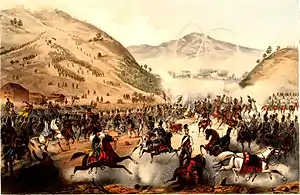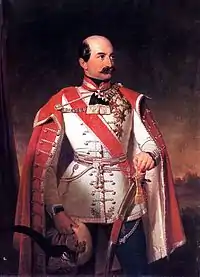Battle of Pákozd
The Battle of Pákozd (or Battle of Sukoró) was a battle in the Hungarian Revolution of 1848, fought on the 29 September 1848 in the Pákozd – Sukoró – Pátka triangle.[1] It was the first and one of the most important battles of the revolution, in which the Hungarian revolutionary army led by Lieutenant-General János Móga clashed with the troops of the Croatian Ban Josip Jelačić.
| Battle of Pákozd | |||||||
|---|---|---|---|---|---|---|---|
| Part of the Hungarian Revolution of 1848 | |||||||
 Battle of Pákozd by Hermann Géza and Róbert Závodszky | |||||||
| |||||||
| Belligerents | |||||||
|
| |||||||
| Commanders and leaders | |||||||
|
|
| ||||||
| Strength | |||||||
|
c. 35,000–40,000 men 99 cannon |
27,000 men 82 cannon | ||||||
| Casualties and losses | |||||||
| c.100–200 killed or wounded | c. 100 killed or wounded[4] | ||||||
Background
The wave of revolutions of 1848 also affected the Habsburg Empire. The multiethnic nature of the empire made it particularly vulnerable to the wave of nationalism sweeping through Europe in the early and mid-19th century. When the news of the Paris Revolution reached Austria, liberal and nationalist tendencies exploded into open revolt. The most serious of these attempts at insurrection were the revolts in Italy (the First Italian War of Independence) and in Hungary (the Hungarian Revolution).
The empire lacked the military strength to crush both insurgencies. The rulers of Vienna therefore decided to concentrate their military forces on the Italian war scene while trying to meet the Hungarian demands. The strategy proved effective and during the summer of 1848 the uprisings in Italy were crushed, freeing troops for a campaign against the Hungarians.
In September of that year, an Austro-Croatian army of nearly 40,000 men, under the command of Josip Jelačić, broke into Hungary. The news of this, combined with the Austrians breaking the promises made as before, created great irritation among the Hungarians, who immediately organized their own army to meet the Habsburg forces.
In an effort to prevent the conflict, Hungarian Prime Minister Lajos Batthyány and Justice Minister Ferenc Deák traveled to Vienna to negotiate with the emperor. However, the journey was fruitless because the emperor refused to meet them.
At the same time as this was taking place in Vienna, Ádám Teleky was appointed commander of the Hungarian army. Teleky was worried that his hastily assembled forces would not be able to compete with the Imperial Army, so he decided to retreat to Székesfehérvár. The withdrawal of the army created great dissatisfaction in the Hungarian parliament, which immediately fired Teleky. Archbishop Stefan was appointed the new commander. Stefan, who wanted to negotiate with the Austrians, invited Jelačić to a meeting at Balatonszemes but he never arrived.
Battle
On the morning of September 29, the Hungarian army had taken advantageous positions between the village of Pátka and the town of Velence. Jelačić's plan was to break the Hungarians' right flank at Pátka and then direct a concerted attack on the center, which he hoped would lead to the total annihilation of the enemy army. The battle began with Major General Kempen attacking the Hungarian positions at Pátka with 8,000 men and forcing the defenders to retreat after a brief battle. The Hungarian right wing, however, went on the counterattack and managed to stop the Austrian advance. Jelačić launched his main attack on the Hungarian center, which was repulsed. After consulting with Kempen, Jelačić began negotiations on a ceasefire while the Austrians withdrew from the battlefield, covered by artillery.
Aftermath

Although the battle ended in an Hungarian victory, the success was not used. A truce was concluded shortly afterwards and the Hungarians withdrew to Martonvásár. Jelačić, who was afraid of being surrounded, organized an orderly retreat towards Vienna. Despite the small size of the battle compared to future battles, the victory raised the morale of the Hungarian army that had managed to meet and defeat the emperor's troops.
In Hungary its anniversary (29 September) later became "National Defence Day" (Hungarian: "a honvédség napja"). In 1991 that day was changed to 21 May (the date of the recapture of Buda at the Battle of Buda (1849)).[5]
References
- "Pákozd-Sukoró Battle 1848 Exhibition". museum.hu. Retrieved 10 December 2009.
- "szeptember. 29. A pákozdi csata emléknapja. Mihály nap ("September 29. Remembrance Day of the Battle of Pákozd. St. Michael's Day")" (in Hungarian, English, and German). sulinet.hu. Retrieved 10 December 2009.
- Urbán, Aladár (1984), "Pákozd, 1848 (előszó) ("pretext")", Szavadsárgharac 1848–1849. ("Hungarian Revolution of 1848–1849"). (in Hungarian), Budapest: Móra, ISBN 978-963-11-3718-7, archived from the original on August 31, 2008, retrieved 10 December 2009
- HERMANN Róbert: A pákozdi csata, Hadtörténelmi Közlemények 127. évf. 2. sz. (2014.), 380. old.
- "Jeles Napok – Május 21. A magyar honvédelem napja" [Important Days – Hungarian Army Day]. jelesnapok.oszk.hu (in Hungarian). National Széchényi Library. Retrieved 18 July 2010.
Sources
- Nemeskürty, István, 1848––49 – Kik érted haltak szent világszabadság ..("1848–49 – Who lived and died for the independence") (in Hungarian), ISBN 963-434-332-5
- Magyarország hadtörténete két kötetben ("Military History of Hungary in two volumes") (in Hungarian), ISBN 963-326-332-8
- Hermann, Róbert (May 1995), A szabadságharc hadserege (""Army of the revolution") (in Hungarian), Rubicon
- Nobili, Johann. Hungary 1848: The Winter Campaign. Edited and translated Christopher Pringle. Warwick, UK: Helion & Company Ltd., 2021.
- Földi, Pál, Ezer év csatái – Kis magyar hadtörténelem (""A thousand years of war – A Shorter Hungarian Military History") (in Hungarian), ISBN 963-9189-01-4
External links
- Péter Krisztián Zachar. "Adalékok a császári-királyi hadműveletek előkészítéséhez és történetéhez" [The Emperor’s operation: background] (in Hungarian). Archived from the original (PDF) on 30 November 2007. Retrieved 13 May 2013.
- "Az 1848–49-es forradalom és szabadságharc Hadtörténelmi Levéltárban őrzött katonai irataiból" [Dispatches of the Hungarian revolution of 1848–9 in the Military History Archive in Hungary] (in Hungarian). Retrieved 10 December 2009.
- (in Hungarian) Video animation about the Battle of Pákozd